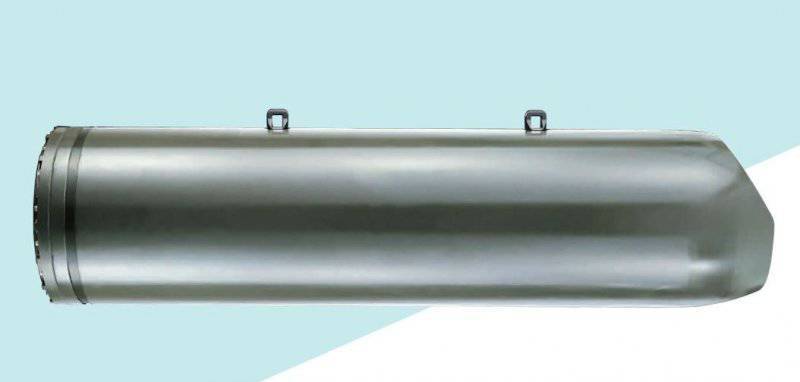
SHAH ALAM: Aerial mine laying. It appears that the RMAF has or is developing the capability for Aerial Mine Laying (AML) using the Hercules C-130H and Airbus A4OOM transport aircraft based on a release from the RMN. It is also likely that the RMN’s Diving and Mine Warfare Headquarters is the operator of the mines though RMAF is expected to lay them when call upon by the higher authorities.
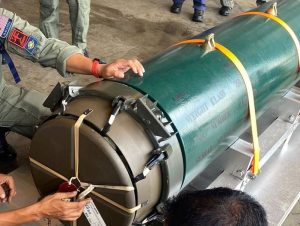
From RMN:
𝐋𝐀𝐓𝐈𝐇𝐀𝐍 𝐀𝐄𝐑𝐈𝐀𝐋 𝐌𝐈𝐍𝐄 𝐋𝐀𝐘𝐈𝐍𝐆 𝟐𝟎𝟐𝟐 𝐏𝐄𝐑𝐊𝐔𝐊𝐔𝐇𝐊𝐀𝐍 𝐏𝐄𝐑𝐓𝐀𝐇𝐀𝐍𝐀𝐍 𝐌𝐀𝐑𝐈𝐓𝐈𝐌 𝐍𝐄𝐆𝐀𝐑𝐀
SUBANG, 30 Nov – Markas Selam dan Peperangan Periuk Api (Mk SPPA) telah berjaya menganjur dan mengkordinasikan Latihan Penaburan Periuk Api atau lebih sinonim dengan Aerial Mine Laying (AML). Latihan ini dilaksanakan secara dua hala bersama TLDM dan TUDM bertujuan untuk menguji serta mengukuhkan kesiagaan Mk SPPA bersama Depot Peluru dan Bahan Letupan Barat (DPLB) dalam aspek keupayaan dimensi Peperangan Periuk Api (PPA) dengan menggunakan platform penaburan udara pesawat C130H dan A400M.
Antara unit-unit TLDM yang turut serta dalam latihan ini adalah PROTELA Lumut dan Depot Kenderaan TLDM. Selain itu, latihan ini turut melibatkan kolaborasi bersama Bahagian Trafik PDRM bagi mengiring dan mengawal lalu lintas sepanjang perjalanan konvoi.
Latihan ini telah berlangsung selama 3 hari mulai 28 sehingga 30 Nov 22 merangkumi 3 fasa iaitu fasa pertama – Penyediaan periuk api dan kenderaan serta pergerakan dari Pangkalan TLDM Lumut ke Pangkalan Udara (PU) Subang. Fasa kedua – Pemunggahan dan pemasangan periuk api di pesawat C130H dan A400M termasuk penyampaian taklimat oleh pihak TLDM dan TUDM mengikut tugas dan tanggungjawab masing-masing sebelum melaksanakan latihan secara praktikal. Fasa ketiga – Pengguguran periuk api yang dilaksanakan secara teori dan taktikal. Sebanyak 8 periuk api telah dimuat naik ke dalam pesawat sebagai latihan dan simulasi pengguguran. Latihan kali ini juga memberi peluang kepada pihak TLDM dan TUDM dalam membangunkan SOP kepada pesawat A400M sebagai platform baharu bagi Operasi Penaburan Periuk Api.
Latihan pada kali ini turut melibatkan perbincangan dan percambahan idea antara TLDM dan TUDM untuk proses penambahbaikan latihan akan datang bagi perancangan latihan yang menyeluruh meliputi peringkat operasional dan taktikal.
Latihan berjaya dilaksanakan dengan lancar tanpa sebarang insiden sepanjang latihan berlangsung. Sesi taklimat, perkongsian ilmu dan perbincangan antara TLDM dan TUDM telah berjaya direalisasikan sebagai nilai tambah bagi mengukuhkan lagi pengetahuan warga berkaitan latihan ini dan penambahbaikan sebagai panduan pada masa akan datang bagi meningkatkan lagi tahap kesepaduan dan kesefahaman pelaksanaan dimensi PPA khususnya antara TLDM dan TUDM.
Selain itu, kemampuan dan kesiagaan aset pertahanan negara juga telah dapat diuji dengan komprehensif dalam mempertahankan kedaulatan maritim negara pada sebilang masa.
Sumber : Pusat PPA – Markas Selam dan Peperangan Periuk Api
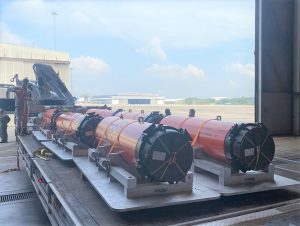
Apart from RMN, No 20 Skuadron which hosted the training event at the Subang airbase also posted on its Facebook page on the training event:
LATIHAN AERIAL MINE LAYING (AML)
Subang, 29 Nov – No 20 Skuadron telah menjadi tuan rumah bagi Latihan Aerial Mine Laying (AML). Latihan yang dijalankan di Auditorium dan dispersal No 20 Skuadron ini melibatkan anakapal No 20 Skuadron, No 8 Skuadron dan No 16 Skuadron. Program yang melibatkan perbincangan halatuju anakapal, latihan penerbangan AML dan Latihan Loading serta Rigging Procedure Mine Laying yang menggunakan pesawat C130H. Latihan seperti ini amat penting bagi menjamin tahap kesiapsiagaan anakapal skuadron masing-masing dalam menjalankan tugas AML di tahap yang optimum dan cekap.
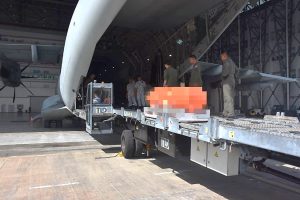
The squadron also posted pictures of the mines – not identified – used during the training – which was not blurred unlike the RMN ones. From the pictures, I believed that they are likely to be the MN 102 Murena mine developed by Rheinmetall division, RWM Italia. I stand to be corrected, of course.
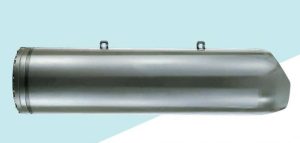
The MN 102 Murena is a multi-influence sea mine designed to be effective against a range of targets. It can be laid by surface vessels, aircraft and submarines, through torpedo tubes or mine belts. It is the third generation of the Italian MR-80 and MP-80/MRP family of mines.
The mine is equipped with acoustic, magnetic and pressure sensors, giving the operator significant flexibility. It has excellent target classification and localization capabilities, making it effective.
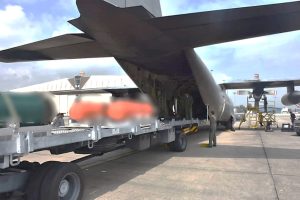
Apart from No.20, the other RMAF squadrons involved were the No.8 Squadron which operates the A400M and the King Air B200T operator, No 16 Skuadron. Apart from the RMAF and RMN personnel, also involved were those from the 10th Para Brigade air despatch squadron. The air despatch squadron is responsible for preparing the items to be air dropped from RMAF transport aircraft, their involvement in the training for the AML is vital.
— Malaysian Defence
If you like this post, buy me an espresso. Paypal Payment

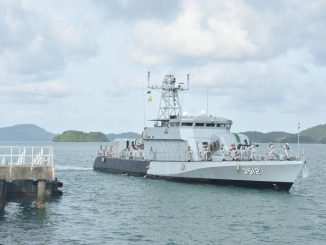
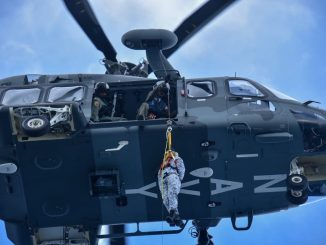
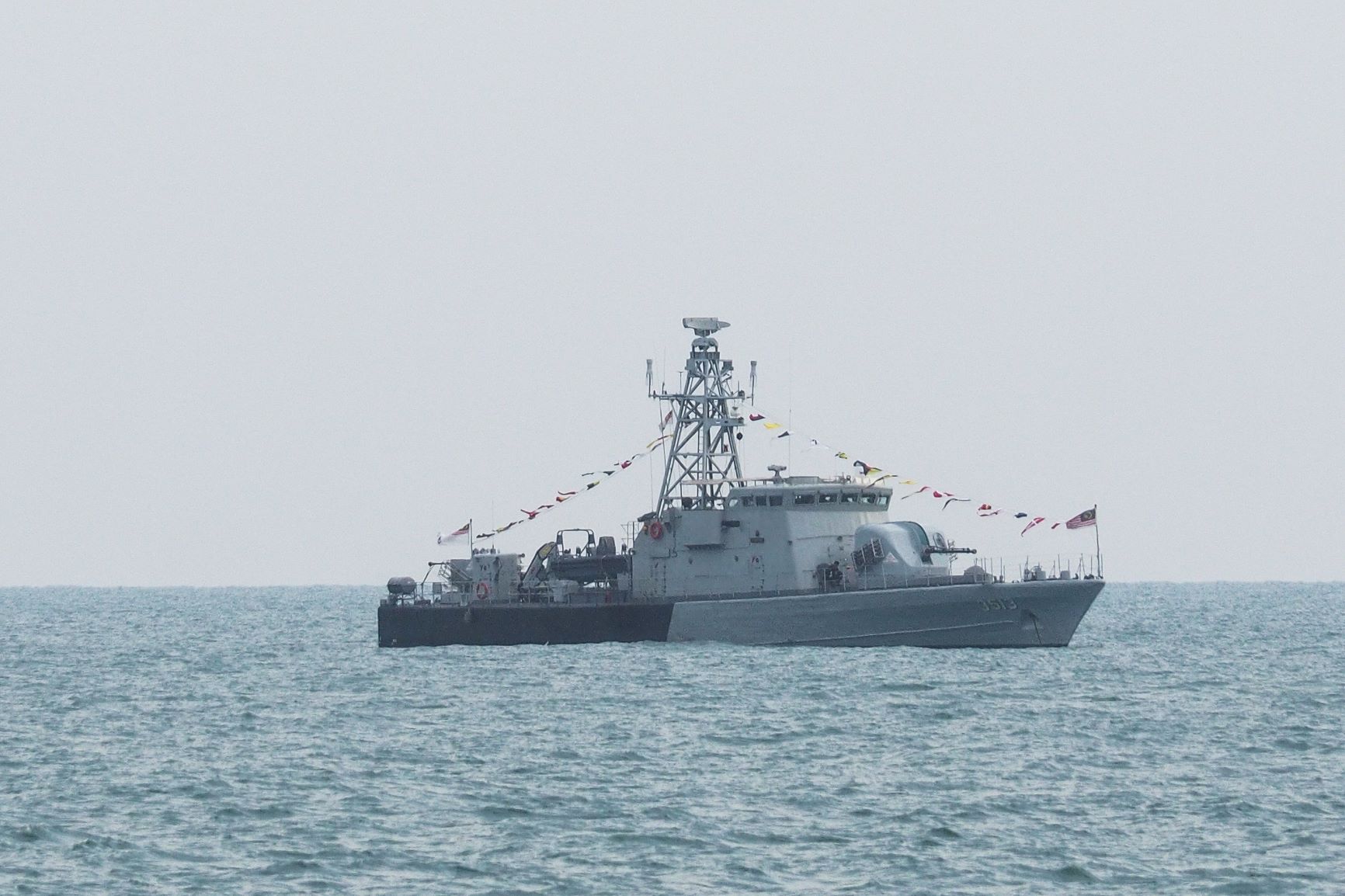
I’ve just talked about requesting Quickstrike naval mine fuse for TUDM in a previous post.
We need to expand our holding of aerially deployed naval mines, as a AA/AD capability of our maritime areas.
Good to know that we are practicing this.
What we need now is aerially deployed naval mines that can be launched at standoff distances. We should include this in for our LCA/FLIT weaponry.
Yes. Most effective n cheapest way to make it difficult for the enemy. Should use a combination of pressure n acoustic mines
hulubalang – ”I’ve just talked about requesting Quickstrike naval mine fuse for TUDM in a previous post.”
Bravo…
hulubalang -”What we need now is aerially deployed naval mines that can be launched at standoff distances.”
”What we need now” is to have the urgency to improve the RMN’s MCM capabilities. The Marhamirus are old and rely on the traditional wire sweep and ROVs – need replacing. Whilst it’s nice to blow trumpets about an aerial laying capability; let’s not overlook that the RMN also needs an improved MCM capability because others too can deploy mines and those mines might not be bottom laid or moored ones with a simple magnetic fuse but ones with an acoustic fuse programmed to detonate upon detecting a certain signature. They can also be ones encased in ceramic casings.
hulubalang – ”We should include this in for our LCA/FLIT weaponry.”
I’ve never heard of fast jets having such a capability.
Lee – ”Most effective n cheapest way to make it difficult for the enemy.”
Whether it’s on land or sea the trick is to also have other means to be deployed with the mines; i.e. if on land a minefield should be covered by MG fire. Failure to do that means the enemy can sweep an area unmolested.
Azlan,
“I’ve never heard of fast jets having such a capability”
Please teach yourself on Quickstrike mines.
http://youtu.be/5VNzwRbAtZc
South Korea has developed their own Quickstrike + glide wings for stand-off deployment. These can be carried by FA-50 and F/A-18D Hornets.
hulubalang – ”Please teach yourself on Quickstrike mines.”
I know what a Quckstrike mine is and have for a while now. A USN P-3 laid one during a CARAT exercise here many years ago.
What I was not aware of is Quickstrikes being abled to be laid by fighters. Thank you for the lesson – I’m always eager to fill in gaps in my education.
Royal Navy is going for commercial-based OSV to be the mothership for their MCM capability.
“NAO report on Equipment Program signals that “up to 4″ MCM Logistic Support Vessels are intended to serve as motherships. An Offshore Support Vessel obtained through quick conversion of existing ship will be used in home waters, and enter service by April 2023”
Malaysia as an Oil & Gas nation has plenty of these OSV to be taken up, many could be had for single digit million ringgits. All it needs are the political will to do it.
That OSV is just for a quick initial capability, follow on ships will be new built ones
while is relative easier to lay mine. our minehunter (mahamiru class) may need an upgrade soon or replacement. I think the last mid lift service was in 2008 which supposed to extend it like for another 10 or 15 years.
But OSV can be multirole, much more than what the LMS can ever do
It can do minehunting, and minelaying. It can do tender to LMS or even submarines. It can stay out at sea for enduring presence. It can resupply offshore bases. It can be SOF mothership. It can do HADR, rescue people, supply water and fuel. You can even put modular missile pods on board and become an arsenal ship (Netherlands Navy are planning to get OSVs to become arsenal ships, see the TRIFIC program)
https://en.wikipedia.org/wiki/TRIFIC-program
Getting OSV costs very little, but can it do so much. We are in a budgetary crunch anyway so why not get OSV now? Many western navies, from the British to the Dutch and even the Australians and French are getting OSV to fulfil their missions.
KC Wong – ”Royal Navy is going for commercial-based OSV to be the mothership for their MCM capability.”
2 schools of thought – One has it because MCMVs no longer rely on wire sweeps and don’t have to be inside a minefield; that purpose built MCMVs aren’t required. Another has it that purpose built MCMVs are still required even if robotics are deployed some distance away from the ship; depends on individual preferences. I have asked people in the MCM community both here and abroad; opinions are mixed.
kdd – ”while is relative easier to lay mine. our minehunter (mahamiru class) may need an upgrade soon or replacement.”
It has received certain upgrades over the years and the intention is to retire them. Under the 5/15; the class is to be retired but the timeline is unknown; simply not a priority in the larger scheme of things.
Wong – ”We are in a budgetary crunch anyway so why not get OSV now?”
Because for the RMN it priority is the LCS and LMS; going for anything else will divert resources which are already severely somewhat stretched. That’s why….
@ Azlan
So which school of thought is cheaper, and can be used for more missions other than just pure MCM?
We need to stretch our Ringgit to the maximum, and get the most out of every single sen.
Wong -“So which school of thought is cheaper, and can be used for more missions other than just pure MCM?”
It all boils down to individual preferences and requirements. No point going for something cheaper but doesn’t provide the needed capability. Not as clear cut you make it out to be. Unlike you; I’m not advocating anything; a sales pitch or an attempt at conversion isn’t required.
Wong – “We need to stretch our Ringgit to the maximum, and get the most out of every single sen”
Right but this is not a PowerPoint slide or an Excel spreadsheet. You can stretch the RM from here to the Pamir mountains but ultimately it has to meet requirements and there’s no point achieving short term savings only to incur penalties in the long run.
@ Azlan
“Because for the RMN it priority is the LCS and LMS”
Used OSVs can be had for the price of FICs. Buying even a dozen used OSVs probably cost less than half the price of the chinese built LMS.
Getting OSVs now will relieve a lot of pressure to the overworked RMN fleet. Get OSVs for both RMN and MMEA.
Thought modern MCM mothership doesn’t have to be custom made ship unlike before.
It’s just any vessel that able to carry the USV,UUV, UAV & the accompanying onboard equipment on the mothership be it fixed to the ship or sit inside a container to perform minesweeping. It can be both unarmed (like the Dutch) or arms (like RSN LMV).
Thought unlike in Europe, RMN would likely do minesweeping in contested environment and a OSV without an escort is like a sitting duck and if it’s need escorts to perform it duties might as well merge the OSV & her escort into 1 ship to save on money in term of procurement, sustainment & labour.
@ Zaft
There is no MCMV in the world that could do minesweeping in contested environment alone.
Even dedicated MCMV at most have a bofors 40mm, nothing more than that.
@ Azlan
There is also no point spending so much for items that would do basic stuff for the rest of its life. Just look at 300 million Kedah Class OPV and 60 million Keris Class LMS. 2 million for a used OSV that can do multi-role is a no-brainer, even if it is used for just 10 years.
Wong – “Used OSVs can be had for the price of FICs”
The hulls need sonar; associated processing equipment; USV and UUVs;amongst other things.
Wong – “Getting OSVs now will relieve a lot of pressure to the overworked RMN fleet”
Great on paper but in reality the RMN is having its energy and focused fully maxed trying to get the LCSs and LMSs. The priority after that in the order of things are the MPSSs.
You also have to note that the danger in having a OSV or any other hull with modular payloads is that the crew might find themselves doing various other things rather then MCM. At least with the Lericis even if they’re on a routine patrol the crew is also required to maintain proficiency with the wire sweep.
The issue of modular payloads have been discussed extensively here before – pros and cons. Some navies swear by them and others won’t touch them with a barge pole. Even within the RMN the issue of modular payloads is one which is agreed upon by some [out of necessity not choice] and opposed by some; like in other navies. We can go further into this if required.
Zaft – “Thought modern MCM mothership doesn’t have to be custom made ship unlike before”
Depends. Individual preferences.
-Some navies still the need for purpose built MCMV$; some don’t.
-Some navies still see the need for hulls to have certain features which make them less susceptible to mines even though the hull does not have to enter the minefield.
– Some navies prefer purpose built MCMVs because with modular payloads crews might not have the needed opportunities to gain and maintain proficiency – MCM is requires a lot of skills which have to be maintained.
Zaft – “Thought unlike in Europe, RMN would likely do minesweeping in contested environment”
Is it written in stone that MCM in the Black Sea or the Med will be in an uncontested environment?
wong – ”Even dedicated MCMV at most have a bofors 40mm”
Most have smaller calibre weapons; a 40mm is not unheard of but isn’t common either. The vibration from firing can affect the sonar.
Wong – ”There is also no point spending so much for items that would do basic stuff for the rest of its life. ”
Pray tell what is ”basic stuff”? There is also ”no point” buying something for the sake of it and gaining short term cost savings only to be straddled with something unsuited for requirements and to incur heavier costs in the longer term [something we have ample experience of BTW].
wong – ”Just look at 300 million Kedah Class OPV and 60 million Keris Class LMS. 2 million for a used OSV that can do multi-role is a no-brainer, even if it is used for just 10 years.”
Again; it depends on individual preference and priorities. Also; you are making blanket statements and assuming that all operational conditions we’re likely to be faced with can be fulfilled by a OSV. You have a penchant for OSVs and I get that. Over the years I’ve had countless discussions with various people trying to make a sales pitch on things they have a penchant for; things they’ve placed on a pedestal. Again; it depends on the RMN; just because something might work for others doesn’t mean it will automatically work for the RMN. Just like how the modular payload concept worked for the Danes but didn’t for others – no fixed rule… There are pros and cons; i.e. it only works if you happen to have the right payload for the operational circumstance faced and a ship’s crew with various payloads to gain proficiency on will in all likelihood have much less opportunity to train on MCM compared to a crew of a purposed built MCMV. Pros and cons – doesn’t mean one’s better than the other.
If the RMN sees a need for OSVs fine; Hallelujah! The reality is however – again – that the RMN is presently focused on LCSs and LMSs; everything else currently is secondary and irrespective of what some harp about the 5/15 as if it’s gospel; the RMN is still undecided on the modular payload concept. I won’t go into the ”no brainer” stuff as I avoid making blanket statements; viewing things in isolation and discussing things as if they’re neat and sound like on a PowerPoint slide; doesn’t mean I’m against OSVs BTW. So no offence but spare me the sales pitch.
KC “There is no MCMV in the world that could do minesweeping in contested environment alone”
That’s why a lot of navy in our region are merging MCM functionality into a surface combatants. The LMV, mogami & PH navy new OPV are all slated to perform MCM.
When a group of smallish countries all face similar ‘pressure’ from a single titan. the logical, efficient, cost effective measure is for all these countries to work to improve their interoperability & interchangeability. Not running around like headless chicken each doing it own things, which would give an upper hand to the titan.
Azlan “Some navies prefer purpose built MCMVs because with modular payloads crews might not have the needed opportunities to gain and maintain proficiency – MCM is requires a lot of skills which have to be maintained”
Another way is that the modular MCM module is permanently fixed into a common hull like the USN LCS currently is.
I am not really selling this idea to you Azlan
You are the least important person to sell this idea
I am just bantering with you so that everyone reading this, especially those that has the power to implement these ideas, can understand where I am coming from.
So just let me put out the ideas as you cannot or won’t put out any suggestions that could improve the state of our defence.
wong – ”I am not really selling this idea to you Azlan”
But you were.. Pushing the narrative that because OSVs are cheap and are used by others that it automatically means it will be suitable for the RMN without taking the various dynamic/factors at play. Also; do your OSVs have the DC standards needed? Has the RMN really made up its mind about modular payloads? If the RMN decided to shelve the LMS and go for your OSVs how long will the bureaucratic process take to sell the idea and get it approved?
wong – ”You are the least important person to sell this idea”
At least we can agree on something. Since we agree on that save your narrative for one like minded…
Wong – ”I am just bantering with you so that everyone reading this, especially those that has the power to implement these ideas”
– You weren’t ”bantering”. You were pushing an idea which for reasons – if you thought about it – simply isn’t feasible or an option.
– You really think ”those that has the power ” have the inclination or time to read this? Do tooth fairies and gargoyles exist?
Wong – ”So just let me put out the ideas as you cannot or won’t put out any suggestions that could improve the state of our defence.”
In simple as possible English if the RMN has a need for OSVs then fine; Hail Mary to you. As for your ”cannot or won’t put out any suggestions that could improve the state of our defence” this sounds very familiar and perhaps you mean that if I don’t agree with you then I ”’cannot or won’t put out any suggestions that could improve the state of our defence”’ – rich/self serving. Putting out ideas that have no bearing with reality does not in my book ”put out any suggestions that could improve the state of our defence”.
zaft – ”That’s why a lot of navy in our region are merging MCM functionality into a surface combatants. ”
That is not the reason. The reason is to gain maximum flexibility and to achieve costs savings.
zaft – ”When a group of smallish countries all face similar ‘pressure’ from a single titan. the logical, efficient, cost effective measure is for all these countries to work”
Only if they have the needed policy in place. Within ASEAN no such arrangement exists [we can go into the reasons why] – profound difference between logic and reality.
zaft – ”Another way is that the modular MCM module is permanently fixed into a common hull like the USN LCS currently is.”
Then it wouldn’t become ”modular” and if the ship at sea say needed a ASuW module a problem would arise.
If LMS2 comes to fruition and obtained in sufficient numbers, the 4units LMS1 could be derated and turned to MCMV roles with the flexibility of their modular mission bays.
”the 4units LMS1 could be derated and turned to MCMV roles with the flexibility of their modular mission bays.”
Given that the MCM modules and associated gear are Western; integrating them to the ship’s existing architecture would be an issue.
“That is not the reason. The reason is to gain maximum flexibility and to achieve costs savings.”
And that’s too.
“Then it wouldn’t become ”modular” and if the ship at sea say needed a ASuW module a problem would arise.”
Yes,It won’t. But it would still derived saving by having a common hull. And assuming one can find a spare ASuw module and experience staff to operate it, a module swapped is still possible
“Only if they have the needed policy in place. Within ASEAN no such arrangement exists [we can go into the reasons why] – profound difference between logic and reality”
Policy are usually put into place after or in anticipation of a crisis.
asean are still divided particularly between the mainland ASEAN with maritime ASEAN. The former are uninterested while the latter are taking baby steps towards it.
zaft – ”And that’s too.”
Not ”and that’s too”. That is the main reason; not your ”why a lot of navy in our region are merging MCM functionality into a surface combatants” – nonsense.
zaft – ”And assuming one can find a spare ASuw module and experience staff to operate it, a module swapped is still possible”
You still don’t get it. A module is only effective as long as it’s the right one to meet the presented operational condition. A major problem with swapping modules is that proficiency issues come into play; things like ASW and MCM need a high level of proficiency and a crew of a hull with modules might need get the level of proficiency needed because in reality a ship will be busy doing various things which is normal in peacetime conditions. Everyone talks about the Danes and Stanflex but hardly everyone realises that even the Danes hardly swap modules. Another issue is that even larger navies – never mind the RMN- are not exactly flushed with experienced staff; especially in ASW and MCM; both are resource and time extensively to gain and maintain proficiency.
zaft – ”Policy are usually put into place after or in anticipation of a crisis.”
Common policy is put in place when there is a consensus on what needs to be done and when there is the drive and urgency. So? Any revelation?
zaft – ”asean are still divided particularly between the mainland ASEAN with maritime ASEAN. The former are uninterested while the latter are taking baby steps towards it.”
Let’s start from the beginning shall we. Again; the various states do not have the shared history as sovereign stares compared to European states; don’t face a common existential threat; have different forms of governance; have different forms of economic and social development and still have lingering mutual distrust amongst each other. Also; what ”mainland ASEAN” and ”maritime ASEAN”? Only Laos is landlocked.
Laos and it’s immediate neighbours BTW are classified as Indochinese states; not ”Mekong Deltae states” as you previously stated.
Take these factors into account before talking about interoperability and commonality; which within ASEAN is is not policy or priority. We are not NATO or the EU; there is no binding treaty within ASEAN and the only ASEAN country which makes it a point to really achieve a high level of commonality nd interoperability with the U.S. is Singapore.
Azlan “what ”mainland ASEAN” and ”maritime ASEAN”? Only Laos is landlocked.
Laos and it’s immediate neighbours BTW are classified as Indochinese states; not ”Mekong Deltae states” as you previously stated.”
It’s amazing that you understood the sentence but yet decided to go on a technicality rants regardless.
“You still don’t get it. A module is only effective as long as it’s the right one to meet the presented operational condition. A major problem with swapping modules is that proficiency issues come into play”
Thanks for repeating & dissecting then elobrate on my point.
“Not ”and that’s too”. That is the main reason; not your ”why a lot of navy in our region are merging MCM functionality into a surface combatants” – nonsense.”
I assumed you have experience in the field during the relative peaceful periods. Thus your believe that the country are stagnant & unchanging and unable to evolve overtime is your own personal bias.
The chinese LMS doesn’t really have modular anything.
It just have spaces to fit 2x TEU containers right in front the boat slipway, and another 2x TEU container space high up on the superstructure, just behind the bridge. When fitted with containers, very little workspaces left. There is also no large cranes for deploying and recovering mine detection and mine neutralising equipments. Is there additional spaces to accommodate MCM personnel, and is there additional work spaces/ work rooms for them in the ship?
The container location up on the superstructure surely have some weight limits on it, to make sure the ship stability isn’t compromised.
In a nutshell, much more easier and convenient to do modular MCM on a spacious OSV rather than on the LMS.
Azlam,
“A major problem with swapping modules is that proficiency issues come into play; things like ASW and MCM need a high level of proficiency and a crew of a hull with modules might need get the level of proficiency needed because in reality a ship will be busy doing various things which is normal in peacetime conditions”
1. Don’t conflate MCM with stanflex. Yes Flyvefisken-class with stanflex did MCM. But that was in the 1990s, where inherently modular anything didn’t really exist. We are now 30years after the stanflex appeared on the Flyvefisken-class, and stanflex has much evolved.
2. The danes then created MCM Denmark concept. MCM Denmark is an innovative MCM concept based on ISO TEU Standard containers (not stanflex) and remotely operated drones up to 125 tons. MCM crews are dedicated and attached to the system itself, ie ship agnostic. MCM Denmark have been deployed with several host platforms, including THETIS-class Ocean Patrol Vessels and commercial Supply Vessels. The concept has been deployed sucessfully several times as an inherent part of NATO MCMGROUP ONE.
3. The availability of multiple mature modular MCM systems. Some prefer to build dedicated ships to hold the modular MCM system, but the system does not need dedicated ships to work. For malaysian-specific scenario, we have very limited budget for RMN. Most of what little budget we have needs to be channeled to complete the LCS. We don’t have the budget to have dedicated MCM, which is why originally RMN wants the LMS to be able to do MCM. But the current LMS is a small 600ton boat, with very little space to carry and deploy heavy and large modular MCM systems. For LMS batch 2 RMN seems to want a conventional corvette for that requirement. Getting OSV is the way forward, which could do many missions that RMN wants the LMS to originally do (HADR, MCM, UAV etc.) with low acquisition and operation cost.
Since we are at mcmv topic. I wonder if depth charges are still being used in navies for submarine counter measures instead of torpedo
Some countries are still equipped with DC others not
KC “For LMS batch 2 RMN seems to want a conventional corvette for that requirement. Getting OSV is the way forward, which could do many missions that RMN wants the LMS to originally do (HADR, MCM, UAV etc.) with low acquisition and operation cost.”
Again, why not just merge the OSV with the surface combatants like most countries currently doing?
kdk,
Some still retain air dropped depth charges – can’t be decoyed, have a short reaction time and useful in shallow water. It’s for the same reason some still retain ASW rockets which can go a certain range.
Zaft,
“Again, why not just merge the OSV with the surface combatants like most countries currently doing?”
Why?
We don’t have money that is why. We have excess OSV idle due to oil price instability that is why. We can have OSVs in service like yesterday that is why.
Used OSV can be had for the price of FIC, single-digit millions.
Dedicated Frigates with multi-mission areas cost hundreds of millions.
“integrating them to the ship’s existing architecture would be an issue.”
The CMS on LMS1 are basically barebones, integrating the sensors to the single 30mm. Any modules would preferably run by its own and have a command station in one of the modules and the MCM gear in the other at the rear. The RHIB ramp could be converted to launch drones and/or towed sonar. Or another way is the modular bays could be permanently converted into housing spaces for the MCM equipment which is still okay since these ships should be spending the rest of its life as MCMV.
@KC Wong
The Keris are a lil bigger than Mahamirus and more flexible in their configuration, with the right type of modules fitted out, it can work. Or else the modular deckspaces can be permanently converted for MCM duty.
OSV is the way to go for what missions we want the original LMS to do.
Buying OSV is a cheap way to get the most mission set possible.
We should just skip LMS Batch 2, and get OSVs and MCM modular mission sets instead, while ensuring LMS is completed on time and on spec.
LMS or LCS?
Zaft – “yet decided to go on a technicality rants regardless”
Look up what the definition is of a “rant”‘ instead of harping about “technicality” issues. Why not do some research before making flawed. None of us are experts but it behooves us to try and get it right as far as we can; failure to do that doesn’t do service to this site.
Zaft – “Thanks for repeating & dissecting then elobrate on my point”
You actually had a point to make?
Zaft – “It’s amazing that you understood the sentence”
It’s “amazing” that you come up with some of the things you do. Like South Korea and Turkey not being interested in long term partnerships; utter nonsense as that is precisely what they’re after and what the Koreans have been trying here for decades? Or is this just another “technicality” similar to the how the RMN must justify or prove itself before gaining funding nonsense?
Zaft – “I assumed you have experience in the field during the relative peaceful periods.”
Do you have actually have “experience”? If you do; hats off. I don’t but I have some basic knowledge of how we conduct MCM thanks to a personal contacts and as part of something else I was doing. Can you actually point out something I said which was technically incorrect?
Zaft – ” Thus your believe that the country are stagnant & unchanging and unable to evolve overtime is your own personal bias”
When exactly did I imply that “country are stagnant & unchanging and unable to evolve” – more nonsense from you. I merely pointed out why countries do the things they do because they are driven by history; how they view the strategic calculus and other things. It’s not my “personal bias” but facts; which you’d know if you bothered to do some objective research before making blanket/incorrect statements. Kindly refer to a previous post where it was also pointed you to you by Marhalim that assumptions you made about our policy are wrong; most of what we’re doing remains unchanged,
My bad
*while ensuring LCS is completed on time and on spec.
”The CMS on LMS1 are basically barebones, integrating the sensors to the single 30mm.”
Is there a CMS? I thought it was only a FCS [like with the South Korean ships] with the nav radar; comms and other things integrated.
”Any modules would preferably run by its own and have a command station in one of the modules and the MCM gear in the other at the rear.”
Normally actual ops would be performed in the CIC [as in the case with the Mahamirus whose CICs are freezing] in close coordination with the bridge where the CO would be located or he might be in the CIC with the XO on the bridge instead. In the case of the Keris class however; if MCM modules were added then ops would be performed in the container and not the CIC [yes the class has one eventhough it has a very basic sensors/weapons fit] but the crew in the container would still have to coordinate their actions with the bridge. It would make sense and make things easier if the module was integrated to the CIC but as it stands this would involved a lot of integration and certification.
”The RHIB ramp could be converted to launch drones and/or towed sonar.”
The ramp will reman the primary means of launching and recovering RHIBs.
The RMN called the Keris thing, a CMS, I think we have to go with that description